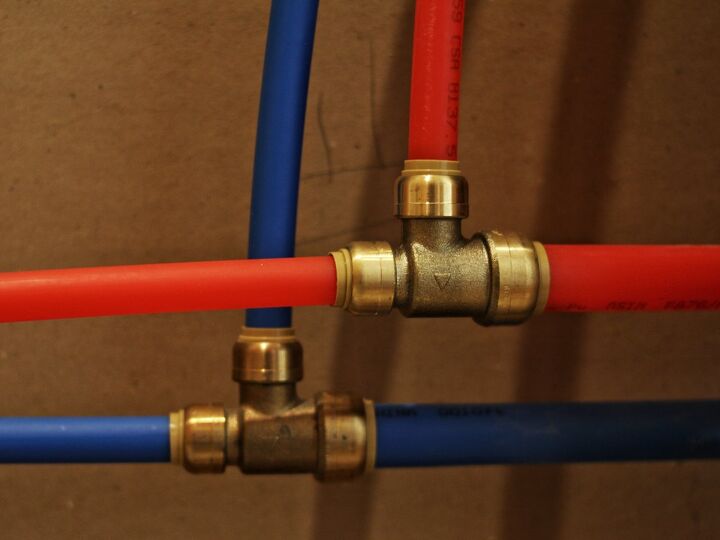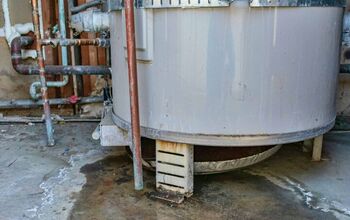Why Are My Sharkbite Fittings Leaking?

Push fittings tend to be known by the popular brand SharkBite. They are sold in just about any major hardware store and through retailers across the web. You might see them in a variety of other names as well, but SharkBite is often the preferred brand.
Every once in a while, these fittings can spring a leak. Should your SharkBite fitting begin to leak, there are a number of fixes that you can implement. It depends on the age of the fitting and the severity of the leak but lots of repair options are available.
Do You Need to Hire a Plumber?
Get free, zero-commitment quotes from pro contractors near you.

How Do SharkBite Fittings Work?
Put simply, SharkBite fittings function by pushing teeth onto pipes, followed by a rubber gasket surrounding the connection. They are designed to create a water tight seal and a connection that is incredibly difficult to pull apart without using a special tool.
SharkBite fittings are popular among DIYers to help accomplish minor plumbing tasks around the home. While they are more expensive than conventional connections, their simple installation is often preferred. Instead of having to solder connections together, the hassle-free install of SharkBite fittings is as easy as pushing pieces together.
As an added bonus, SharkBite fittings can be used on CPVC, PEX, and Copper, making it a well-rounded connector.
Can SharkBite Fittings Leak?
SharkBite fittings are designed in a particular way that should prevent leaking. However, that’s not to say that they can’t leak. Since SharkBite fittings have only been around for roughly 15 years, they haven’t had enough time to be perfected. In fact, some experts have begun questioning the reliability of the internal rubber gasket at creating a water seal.
What is a Push Fitting?
There are lot of names for this kind of fitting: push-to-connect, push-to-pull, push-fit, and instant fittings are all common names. Generally speaking, this is a type of quick connect or compression fitting that can be easily installed and removed.
The idea is that it allows a water or air line to be attached without needing to implement tools. Of course, you would still have to cut tubing to the necessary length, but that would be all you would need when using a push fitting.
Push Fittings Commonly Have Leaks
Though push fittings have risen in popularity over the years, they have also led to a stark rise in leaks. Push fittings are pretty reliable but that doesn’t mean that they are impervious to leaks. Keep in mind that they are quick, easy, and convenient to use but they will have their specific limitations.
That being said, there are things that you should and should not do in order to both prevent and fix leaks in your push fittings. Follow these and you should be able to prevent most problems or resolve them in short order.
No Saws
It is important that you never, ever, ever use a band saw or hacksaw when you cut your pipe. This will lead to inconsistent, uneven cuts that can spring a leak. Make sure that you use a pipe cutter to get the cleanest, squarest cut.
The reason for this is that any inconsistency or unevenness can lead to the push fitting sitting in an uneven manner. Without proper coverage, it would be much more susceptible to springing a leak and requiring repair or replacement.
Don’t Reuse Your Push Fittings
Push fittings have an O-ring inside that has a lubricant applied to it. That lubricant gets gradually wiped off whenever the pipe gets removed and re-inserted or whenever a fitting gets re-used. And there are definitely some companies that will allow a fitting to be used up to a half dozen times.
Still, it is a good idea to at least limit re-use of your fittings if you can’t replace them each and every time. Try to re-use them no more than a couple of times to ensure that they retain that lubricant, allowing the O-ring to stay seated and properly seal out water.
Proper Reaming and Cutting of the Pipe
As stated earlier, it is important that the fitting sit securely onto the end of the pipe. A wrong cut can lead to improper seating, leading to leaks. Make sure that you have a sharp blade for cutting and avoid excessive force. That can deform the pipe and at best will require more deburring to create a smooth edge.
Try using a deburr or reaming tool on the inside of the pipe. This will reduce any turbulence and result in a cleaner cut. Those abrasive edges can be hard to spot and even the smallest inconsistency can result in improper seating of your push fitting. Improper reaming is one of the biggest contributing causes of O-ring failure.
Use a Stiffener
Using a stiffener with your SharkBite fitting can be highly beneficial. A stiffener can be great for helping to maintain the round shape of the O-ring in order to ensure that the seal stays watertight. These should be considered a requirement, not a recommendation.
You can get away with not using a stiffener, but it increases the odds of the O-ring losing its watertight shape and allowing leaks. Check to see if the stiffener has been compromised if you are still experiencing leaks.
Remove the Stiffener Properly
When the time comes to remove the stiffener, it is key that this step is done properly. Stiffeners can go bad, but the fitting can potentially be re-used. Without proper removal methods, it is possible to damage the fitting, requiring immediate replacement of that as well.
Make sure that you use needle-nose pliers when removing your stiffener from the pipe or tube. Use your pliers to hold the insert, pushing on the lip of the fitting. You can use a disconnecting tool to do the pushing while firmly and carefully pulling the insert out.
Pressure Test Your Fitting
Installed push fittings should be pressure-tested before they are actively put into use. This is standard for just about any system. The idea here is to air test it to ensure that your fitting can stand up to the recommended pressures.
It is also better to find out if the fitting that you bought fails before it goes into active use. This way, you can quickly replace the fitting without having a nasty leak spring up first. Always test out your product before putting it into use.
Don’t Sand the Copper Pipe
Smoothing out the edge of your pipe can be very easy with sandpaper. Having said that, it should not be the first method that you go with. Sanding can cause disruptions across the even surface of the pipe which can compromise the seal.
If you do decide to sand the pipe, you should use only a fine grit of sandpaper. Not only that, you should only use it over the very edge of the pipe using a circular motion and very light pressure. This should help to prevent those surface disruptions that can lead to improper seal from taking place.
Push Fittings are Only Meant for Certain Types of Pipe
Push fittings in general are only intended for use in PEX, copper, or CPVC piping. There is another type known as PEX-AL-PEX which as a similar outside diameter to PEX. The composition of the former, however, don’t make it an appropriate fit when using push fittings.
Trying to use push fittings on other types of piping will lead to issues of leaking almost immediately. Not only that, there is a risk that the push fitting will not conform to the pipe, damaging its shape as well. That can lead to a need to replace the SharkBite fitting before it ever really gets use.
Push Fittings Should Not Be Used Outdoors
If you are considering using push fittings outdoors in construction projects, do not. This is because the construction of the push fitting is not meant for continuous exposure to UV sunlight. The exposure over time can lead to the push fitting becoming brittle.
Should the push fitting be exposed to sunlight on a regular basis, it will wear down over time. It won’t take a completely broken-down push fitting to render it ineffective. It will, however, require you to completely replace the push fitting as soon as possible to prevent further leaks.
Do You Need to Hire a Plumber?
Get free, zero-commitment quotes from pro contractors near you.

Final Thoughts
Now that you are aware of some of the advantages and limitations that come along with SharkBite fittings, are they really worth it? Due to their simple operation, these connectors can make both your installs and repairs a breeze. They are the ideal choice for small projects and replacements around the home, such as:
- Temporary installs during renovations
- Connections underneath sinks
- Inside garages
- Water heater installs
With that said, the longevity of SharkBite fittings is still relatively unknown and you should strongly consider not placing them in your walls. As far as small projects for homeowners and water heater installs are concerned, these connectors are great. If a leak does happen to occur, the problem can be easily remedied since it’s easily visible and accessible.
Related Guides

We are a team of passionate homeowners, home improvement pros, and DIY enthusiasts who enjoy sharing home improvement, housekeeping, decorating, and more with other homeowners! Whether you're looking for a step-by-step guide on fixing an appliance or the cost of installing a fence, we've here to help.
More by Upgraded Home Team

















![10 Most Dangerous Neighborhoods in Baltimore [Updated]](https://cdn-fastly.upgradedhome.com/media/2023/07/31/9075655/10-most-dangerous-neighborhoods-in-baltimore-updated.jpg?size=350x220)









